Gloucestershire Wildlife Trust was founded in 1961 by a group of volunteers, led by Sir Peter Scott, who recognised that local wildlife was under threat.
Gloucestershire Wildlife Trust was founded in 1961 by a group of passionate volunteers, including Sir Peter Scott, who recognised that local wildlife was under threat.
Since that first meeting, 60 years ago, the Trust has grown from strength to strength and now has over 450 active volunteers and 27,000 members. Here are just some of the key events over the past 60 years...
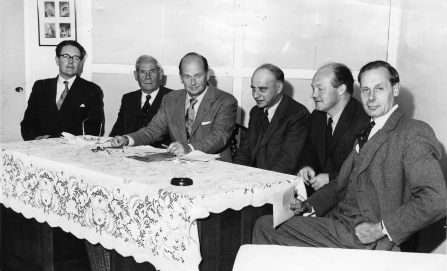
From left to right: Mr. John Pontin, Lord Hurcomb, Mr. Peter Scott, Mr. E. M. Nicholson, Mr. J. H. Hemsley and Mr. J. C. Cadbury
1961
In 1961 the natural wealth of wildlife had been badly affected by post-war farming and the building of new housing and transport links. Gloucestershire's characteristic pre-war species such as the otter were facing local extinction.
The Trust's home was in Community House, College Green, next to Gloucester Cathedral, a location for TV dramas and Harry Potter film shoots.
GWT begins to recruit its first volunteers.
1962
The Trust acquires its first nature reserve - Badgeworth Pool.
At the time it was England's smallest reserve at 290m², and the only known UK location for the adders-tongue spearwort - otherwise known as the Badgeworth Buttercup.
1964
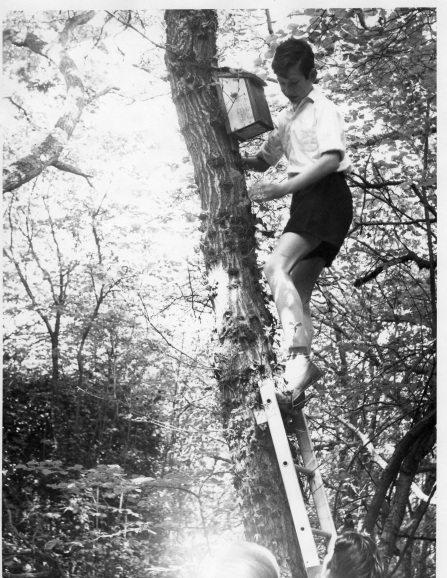
A nest box scheme was started at Betty Daw's Wood nature reserve. It was a great success and helped many species such as the nuthatch wren and marsh tit to breed.
1966
The Trust leases Five Acre Grove, one of the few surviving ancient woods in the Severn Vale.
1971
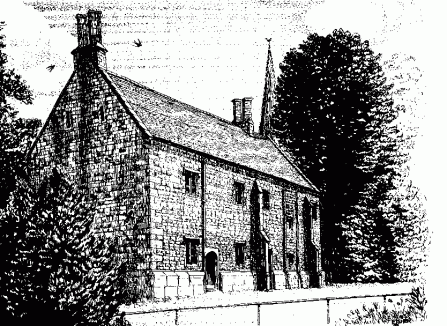
GWT moves to its new HQ - Church House at Standish, Stonehouse, after outgrowing the premises at Community House.
By our 10 year anniversary, 33 nature reserves were managed, and five awards had been received for European Nature Conservation Year.
1976
GWT’s Schools Nature Quiz established by the Trust’s Engagement and Learning volunteers.

1983
Cannop Bridge Marsh nature reserve opened to the public, it is surrounded by relics of the area's industrial heritage.
1985
Coombe Hill becomes a GWT nature reserve - Coombe Hill Canal, which is 3.75km long, is purchased by the Trust from the liquidators of the Severn Canal Carrying company, with funds from The National Heritage Memorial fund, Nature Conservancy Council, World Wildlife Fund, local Individuals, landowners and the Trust.
1992
Sir David Attenborough opened new headquarters at Robinswood Hill Country Park in Gloucester.
Gloucestershire Wildlife Trust's name becomes official in this year, launched by Professor David Bellamy. Previously we’d been known as The Gloucestershire Trust for Nature Conservation.
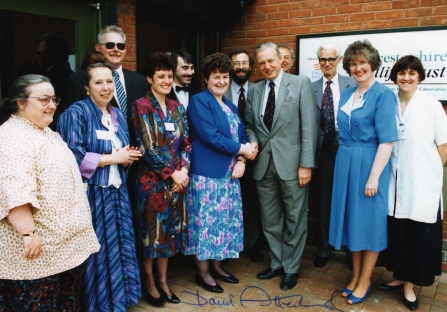
1995
The Trust was one of the first charities to receive an Investor in People Award for our long standing commitment to our staff and volunteers.
1997
HRH The Prince of Wales opened Lower Woods nature reserve.
2000
The Trust organised one of the first Biodiversity Action Plans. Its benefit was to provide a framework for organisations that should include wildlife conservation in their work.
Large blue butterfly reintroduction begins at Daneway Banks.
Coombe Hill nature reserve grows - with support from The National Heritage Lottery Fund, English Nature and the Environment Agency, the Trust purchased 138 acres of mainly arable land immediately to the north of Coombe Hill Canal. This area, once important wetland but then degraded, was acquired for a unique and exciting project - to reverse the loss of habitat and to re-establish wet grassland, and excavate scrapes for breeding and visiting ducks and wading birds.
This work aimed to create the right conditions for a number of key species including lapwing, snipe, curlew and redshank, as well as re-establishing the natural floodplain flora. It also aimed to encourage the natural return of otter and water vole as breeding species as well as providing enhanced habitat for a range of other plants and animals.

The Prince of Wales at Robinswood Hill in 1995
2004
The Trust received a special 10 year award from Investors in People.
Coombe Hill grows - South Meadows are purchased with help from The National Heritage Lottery Fund. Extending the reserve by a further 22.97 hectares.
2008
Gloucestershire's first living landscape (The Severn Vale) was launched.
2009
Coombe Hill grows (again!) - GWT purchase the ‘Notcliffe Fields’ at Coombe Hill - further extending the nature reserve and securing additional habitat used by ground nesting birds and brown hare.
Volunteer milestone - The Trust now has over 300 active volunteers working across many different departments – from Engagement and Learning, to Land Management.
2010
A big milestone - The Trust gained its 25,000th member!
2011
Turning 50 - The Trust began its 50th Anniversary with a huge number of events to celebrate the milestone.
2013
Urban engagement - We begin to focus on engaging with the urban communities around Robinswood Hill, launching the project All Paths Lead to the Hill.
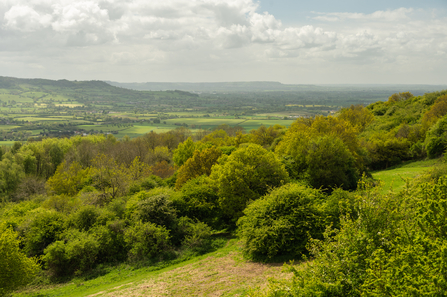
Robinswood Hill by Nathan Millar
2014
Brighter Futures - GWT starts its Brighter Futures courses and, thanks to the Office of the Police and Crime Commissioner, the Morrison’s Foundation and other funders, we are able to continue the courses for five years, supporting local people to improve their local green spaces, learn new skills, develop their existing ones and increasing their chances of finding paid work.
Greystones Farm - GWT secures funding from The National Heritage Lottery Fund to rebuild Greystones Farm, transforming it into a visitor centre and learning space that tells the intertwined stories of wildlife, farming and people at this important place. Over the course of the project 3896 people attended events at the farm with a further 2442 young people learning about its wildlife and history. It is now the home of our learning programme.
Snows Farm - Purchase of Snows Farm ‘extension’ included 2.5 hectares of grassland to improve connectivity of habitats within the Slad Valley.
2015
Wetland improvements - The Trust employs the use of the RSPB’s rotary ditcher to create further wetland features adjacent to the existing scrapes at Coombe Hill. A series of linear foot-drains of various profiles and depths are formed to provide feeding opportunities for breeding waders and their chicks. The features were designed around the needs of redshank, which had not been seen breeding here for a number of years. Since the creation of the foot-drains, two pairs of redshank successfully bred annually at Coombe Hill.
2016
GWT adds Daneway Banks to its list of nature reserves- Extensive scrub control begins at Daneway Banks following the purchase of this beautiful nature reserve. Within three years, hardworking GWT staff and volunteers had doubled the amount of grassland and large blue butterfly habitat here.
Transfer of Gloucestershire County Council sites to the Trust - Gloucestershire County Council transfer their Countryside Sites to GWT. The Trust becomes the new guardians of Crickley Hill, Barrow Wake, Coopers Hill, Kilkenny and Coaley Peak – among these are a Special Area of Conservation, a Site of Special Scientific Interest and a Local Wildlife Site. The Trust continues to manage and enhance these places for wildlife whilst significantly improving the visitor facilities at Crickley Hill.
Our Bright Future - We launch the Gloucestershire branch of Our Bright Future - an ambitious and innovative partnership led by The Wildlife Trusts which brings together the youth and environmental sectors. The £33 million programme, funded by The National Lottery Community Fund, is formed of 31 projects across the UK. Each project helps young people aged 11-24 gain vital skills and experience and improve their wellbeing. At the same time, they act as catalysts for delivering change for their local environment and community; whilst contributing to a greener economy.
GWT gains its 400th volunteer!
2017
Pine marten reintroduction - A project to reintroduce pine marten to the Forest of Dean gets underway with feasibility work starting this year.
Conservation grazing in the Forest of Dean begins - GWT enters into a partnership with Forestry England, with a formal agreement to manage larger areas of the forest as nature reserves, and deliver priority heathland habitat restoration on a landscape scale. The National Heritage Lottery Fund supports the Foresters’ Forest programme. The first year of this conservation grazing project sees the recruitment of a grazing officer to manage the welfare of our conservation grazing animals in the Forest of Dean and work towards landscape-scale habitat restoration.
Conservation grazing at Snows Farm - A New conservation grazing regime begins at Snows Farm with year-round grazing using rare breed cattle and ponies. Plants thought lost to the reserve are recorded within three years - including fragrant and greater butterfly orchids.
2018
Café opens at Crickley Hill
Cotswold Canals Connected project - GWT begins development of the environmental aspects of this project, which brings together different partners to restore 6.4km of canal and create 21 hectares of priority habitat. The result will be a blue-green corridor between the Severn Estuary and Stroud, and a net gain for biodiversity.
White-clawed crayfish - Native white-clawed crayfish were successfully translocated into the Dillay Brook, a tributary of the Slad Brook, at Snows Farm. The animals were moved from the Climperwell Stream which was, and remains, under threat from the non-native signal crayfish population of the upper River Frome. These headwaters of the Slad Brook are ideal for the reintroduction of white-clawed crayfish on account of the absence of signal crayfish from the whole Slad Brook catchment (with a very low risk of “natural” invasion) and because the instream habitats have been enhanced by the addition of “leaky” woody debris dams, installed as part of our natural flood management (NFM) scheme in partnership with Stroud District Council – The leaky dams provide food and refuge for native crayfish.
Building with Nature - Building with Nature is created, developed by GWT, as a new benchmark for the design and maintenance of green infrastructure in housing and commercial development. It aims to support the creation of high-quality green infrastructure throughout the planning and development process, particularly for wildlife.
Learning programme - Relaunching this year with the development of our learning centre at Greystones, the learning programme at Gloucestershire Wildlife Trust now has a countywide curriculum-linked programme for schools, supports young people struggling in school with an alternative curriculum programme, and runs regular pre-school activities across the country.
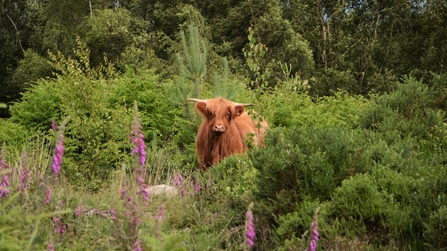
2019
Visitor Hub opens at Crickley Hill
Nature Recovery Networks - Nature Recovery Networks (NRN) are proposed by Wildlife Trusts and adopted by Government to put the Lawton principles of ‘Bigger, Better, More and joined up’ into practice. GWT leads the way and produces an NRN as an evidence-based blueprint for nature’s recovery in Gloucestershire, making it one of the first counties in England to have one.
Pine martens return to Gloucestershire - Following two years of feasibility studies investigating the reintroduction of pine martens in Gloucestershire, 18 pine martens are translocated from the Scottish Highlands and released into the Forest of Dean. ‘Project Pine Marten’ is a collaborative project between GWT, Forestry England, Vincent Wildlife Trust, Woodland Trust and Forest Research.
Nature on Prescription - Gloucestershire Wildlife Trust’s first Nature on Prescription project, working with cardiac event patients, starts - with commissioning from Gloucestershire’s Clinical Commissioning Group.
First cattle at Woorgreens - This year sees the successful ten-week trial of cattle grazing Woorgreens nature reserve in the Forest of Dean, for the first time. GWT purchases six Highland cattle for conservation grazing open habitat sites in the Forest of Dean. The purchase of cattle to graze these sites is a huge milestone for the project. The cattle replicate large herbivores which would have roamed the forest thousands of years ago and introduces natural processes for helping to maintain vegetation structure which benefits wildlife that depend upon these open areas of forest for survival.
Large blues booming - The largest known population of large blue butterflies in the world is recorded at Daneway Banks, where the butterfly was reintroduced in 1999, 2002 and 2010. Over 250,000 eggs are laid!
Eel tile work - We fixed eel tiles to a number of weirs in the lower River Frome (downstream of Stroud). The European eel is critically endangered and these tiles will allow eels and elvers to move upstream of what would otherwise be a barrier to their natural movement. The action complimented a wider programme of works being undertaken by the Environment Agency, the Severn Rivers Trust and ourselves to improve fish passage on other obstructions in the lower River Frome.
White-clawed crayfish - Further reintroductions took place suitable headwater streams in the wider Frome catchment. GWT carried out the work in 2018-19 using funding from Severn Trent Water. We are actively seeking funding to continue our white-clawed crayfish recovery work in the Frome catchment in 2021 and beyond.
Wild Towns - With funding from the European Regional Development Fund (ERDF), the Wild Towns project is launched to create, connect and enhance green spaces for wildlife in seven towns across Gloucestershire. Planned work includes creating wildflower-rich meadows, managing woodlands, removing barriers to fish passage, wetland creation, infrastructure projects, conservation grazing and providing habitats and refuges for key species such as adders, water voles, bats and invertebrates like the small pearl bordered fritillary butterfly.
Dimmel’s Dale becomes GWT’s latest nature reserve - The Trust purchases Dimmel’s Dale – an area of species-rich grassland and ancient woodland in Stroud’s Golden Valley, where woodpeckers, cowslips and devil’s-bit scabious can be spotted.
The Trust’s volunteers clock over 33,000 hours to date!
2020
Learning online - In response to COVID-19 we expand our online presence. With enhanced digital content, we observe a significant increase in visits to the website and followers of our social media channels. We now have a dedicated teacher's resources webpage full of curriculum-based learning videos.
New community hub and café at Robinswood Hill - Building work at Robinswood Hill is completed. Although COVID-19 restrictions delay the full opening of both the new visitor facilities and the café, the café begins to provide a popular takeaway service in line with government guidance.
Return to the Hill - A project to engage with Robinswood Hill’s urban communities can finally get underway, after being delayed due to COVID-19 restrictions. Funded by The National Heritage Lottery Fund, the project seeks to build on the strong relationships the Trust has developed with local communities over the past seven years. Return to the Hill marks the next phase of this journey celebrating a unique part of Gloucester’s natural heritage and hopes to enable people to connect with the wildlife on their doorstep.
Estate review and Priority Landscape Areas - The Trust launches its Estate Review - a review of all their owned and managed estate to ascertain its ability to deliver an ecologically coherent and resilient network of wildlife-rich sites, enabling nature to not only recover but also to adapt to climate change.
By focusing on a smaller number of larger Priority Landscape Areas (PLA), based around the organisation’s biggest and best nature reserves, the Trust will be able to increase the amount of land it manages for wildlife from 1,078 ha to more than 2,000 ha within five years.
Comeback kits - The newly released pine martens breed successfully - with at least four females giving birth to kits.
The return of the ‘Woodsman’s Friend’ - Targeted woodland management at Siccaridge Wood including coppicing, scalloping rides and increasing glades sees the return of the Pearl Bordered Fritillary butterfly after a 20 year absence. Working with neighbouring landowners, the Trust now plans more woodland management work to enable the butterfly to disperse further throughout the valley.
Creating scrapes at Coombe Hill - Work begins to enhance the existing scrapes at this wetland nature reserve - adding a diversity of height, shape and size to these breeding wader islands, which gives birds increased nesting options. The work also helps to avoid territorial conflict for prime nesting sites and acts as a form of predator control by having a more complex perimeter for mammals to negotiate. Higher islands are available for earlier nesting species like lapwing, whilst more edge habitat provides increased feeding opportunities for newly hatched chicks.
The first avocets breed successfully at Coombe Hill. Three pairs of these iconic birds raise chicks which fledge and therefore increase the population.
Woorgreens grows - The nature reserve expands further, now totalling 98.06 hectares and being managed to restore open heathland habitat in the central Forest of Dean.
2021
Wild wellbeing - GWT continues to deliver Nature on Prescription projects in 2021 - supporting carers’ health and wellbeing through our ‘Carers in Nature’ project and supporting children and young people’s mental health through our ‘Nature Nurtures’ project.
Golden Valley Priority Landscape Area launch - This year sees the launch of our first Priority Landscape Area (PLA) project in the Golden Valley working with private landowners to double the amount of land managed for wildlife. This project is funded by the BIFFA Award, and our partners - the Cotswold National Landscape and the Royal Entomological Society. Further funding is secured through the Green Recovery Challenge Fund.
Blackness Banks - The Trust purchases Blackness Banks, a Local Wildlife Site at the foot of the Golden Valley near Stroud. This latest nature reserve is a key stepping-stone, providing further habitat links within the Priority Landscape Area and has records of nationally threatened plants and invertebrates - including autumn lady’s tresses, as well as small blue and large blue butterflies.
Martens on the move - Pine marten scat surveys and sightings show that the reintroduced pine martens and their kits are spreading through the county of Gloucestershire and into neighbouring Herefordshire.
Celebrating 25 years with Grundon - We celebrate 25 years of working in partnership with Grundon Waste Management. During this time Grundon have supported a variety of projects across the county ranging from wetland habitat restoration in the Severn Vale, to a community garden in Cheltenham, to conservation of adders at Crickley Hill.
Cotswold Canals Connected project gets moving - Delivery begins on the Cotswold Canals Connected project - a three-year programme which will create 21 hectares of priority habitat within a Priority Landscape Area (PLA), plant over 30,000 shrubs and trees, establish 4km of new hedgerow and 2km of wildflower-rich towpath verge, all of which will ensure the project delivers a net gain for biodiversity and becomes the first UK infrastructure project to achieve Building with Nature accreditation.
Further eel tiles to be installed - Following the hiatus of 2020, further eel tiles to be installed on obstructions in 2021. GWT is carrying out the work using funding awarded by the Environment Agency from the European Agricultural Fund for Rural Development.
